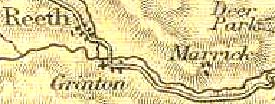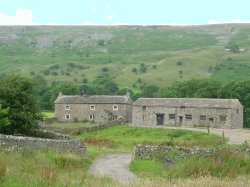I came across Margaret Tiplady quite by chance when I was searching for missing spouses in the Swaledale censuses. I later collected lots of information about the two families, and my husband John decided it would make a good story. So here it is.
Some marriages are a loving and sharing partnership that lasts a lifetime. Many others, I suspect, settle by degrees into a routine tolerance of the other partner's eccentricities. As Ogden Nash put it,
Husbands are indeed an irritating form of life,
And yet through some quirk of Providence most of them are really very deeply ensconced in the affection of their wife.
Other relationships end abruptly, in acrimony and bitterness. Margaret Tiplady's marriage was unlike any of these.

She was born Margaret Chalder in the summer of 1815, at Marrick, in Swaledale. Marrick was a small lead-mining village a mile or two down the valley from Reeth. Her father George earned a comfortable living as a lead mine agent. He was the mine-owner's representative, which meant that he was responsible for negotiating deals with the mining teams as well as ensuring that the mine itself continued to function properly.
George Chalder had married Mary Binks two years earlier, when he was 35 and she was 33, and Margaret was their second child. She had an older brother, Thomas, and a much younger brother, Joseph.
 The brothers left home pretty much as soon as they could (they disappeared off to Manchester and became drapers), and in 1841 Margaret was living with her parents in a house on the edge of the village and next door to someone who described himself as a 'gentleman'. Her father told the Census enumerator that he too was 'of independent means'.
The brothers left home pretty much as soon as they could (they disappeared off to Manchester and became drapers), and in 1841 Margaret was living with her parents in a house on the edge of the village and next door to someone who described himself as a 'gentleman'. Her father told the Census enumerator that he too was 'of independent means'.
In 1843, Margaret married a man named Edward Tiplady. He was a farmer's son, living at the first farm you come to as you walk up the valley out of Reeth. In the days before the railway, most people wisely chose to marry partners who lived close enough to walk home from at the end of an evening's courting. Not that they had much choice.
Edward Tiplady was a couple of years older than Margaret. He was christened at the Low Row Independent chapel in 1813, where like his father he had been baptised "Edmond". But the name was already falling into disuse among the younger generation, and by the time he was a young man he was known as Edward. He had a sister Jane, four years older than he was.
 She ran the household - their mother had died some years before. His other sister, Hannah, had married a young draper named John Bradbury a few years earlier. There was a Tiplady House in Low Row in 1841, a sign that the family name had once been important, but the Tiplady family was long gone by then. Edmond and Edmond, father and son, were down the valley at their 30-acre farm at Townend Hall.
She ran the household - their mother had died some years before. His other sister, Hannah, had married a young draper named John Bradbury a few years earlier. There was a Tiplady House in Low Row in 1841, a sign that the family name had once been important, but the Tiplady family was long gone by then. Edmond and Edmond, father and son, were down the valley at their 30-acre farm at Townend Hall.
The first official notice the state took of these families was in the 1841 Census, and the state managed to get it wrong. Edward Tiplady appears twice in the record - once at home with his father in Healaugh, and once again at the house of his brother-in-law John Bradbury in Reeth. Probably, what happened was that his father had filled in the census forms a day or two before the due date and had assumed that his son would be at home on the 6th, as usual. But young Edward decided to go out that night instead, and ended up sleeping in Reeth. The diligent John Bradbury then added his name to his own house's form, as he was duty bound to do. Edward Tiplady's exact location on the night of 6 June 1841 remains a quantum mystery, like the fate of Schrodinger's Cat, though rather less interesting.
In 1844, a year after their marriage, Margaret and Edward (or Edmund, as the record more correctly states) had a daughter. They baptised her Mary Chalder Tiplady, in Marrick. Since it was then uncommon to give a child two names, and still less common that one of them should be the mother's birth name (or maiden name, as we used to say before it became politically incorrect to suggest that women might still be maidens when they married) the implication is that the Chalders were comfortably off, and the young couple felt it could do no harm to stake a quiet claim to whatever might someday be left.
As things turned out, Mary was to be (almost) their only child.
By the spring of 1849 Edward's father, old Edmond, was feeling the weight of his 72 years. (The 1841 Census had got his age wrong, as it did most people's.) He made a will, leaving £200 to Jane but only £150 to Edward, and signed it. The Bradburys witnessed the will. They were left just £50. But then the summer arrived, and the old man began to feel better. In the autumn of the following year he decided that his bequest to Hannah Bradbury might be considered rather mean, so he added a codicil to the will which left her a further £10. The codicil was signed with a wobbly X. A month later, he died.
It would have been natural for Edward and Margaret to move to the farm soon after their marriage, and make it their home. But that's not quite what happened. The Census of 1851 shows that the couple were living separate lives.

Edward was at the farm in Reeth, with his sister Jane. She was by now 41, still unmarried, but with a young daughter
 who seems to have been the result of a brief fling with a young man named - appropriately enough - Roger Horn. (We know this only because when Anne got married, at the age of 18, she gave her father's name to the parish clerk.)
who seems to have been the result of a brief fling with a young man named - appropriately enough - Roger Horn. (We know this only because when Anne got married, at the age of 18, she gave her father's name to the parish clerk.)
Margaret and her daughter had returned home to her father in Marrick. Margaret's father described her occupation as 'servant', and from this it seems clear that the old man now really needed full-time care, and she would have felt it was her duty to provide it.

But if this was this a short-term emergency, why did Margaret bring her daughter with her? Had she decided that she could no longer live with her husband and his family?
In situations like this, where questions hang in the air unanswered, the Census interval of ten years is frustratingly long. Did Margaret return to the farm a few months later? Did Edward care greatly that she wasn't with him? Perhaps. It's clear that they did live together again as a couple after Margaret's father died, at least for a while, because in autumn 1854 Margaret gave birth to another daughter, Nancy. The Grinton baptism record shows that Edward was her father.
Anyway, by 1861 the farm has gone. Edward is now an agricultural labourer, lodging with another John Bradbury in Reeth. This John Bradbury is a grocer-and-draper, married to a woman called Ann, and maybe a cousin of Edward's brother-in-law John Bradbury the tailor-and-draper, who is married to Hannah. It's all quite confusing, especially as some women baptised Hannah insisted on calling themselves 'Ann'. But there really were two John Bradburys in Reeth at the time - both of them appear in the census, together with their respective families.

Edward's unmarried sister Jane is also in Reeth, housekeeping for the unmarried grocer next door. Meanwhile the enterprising Margaret has established herself as a grocer in Marrick, calls herself the Head of household, and has placed her elder daughter Mary in service at a vet's house in Richmond.

Marrick itself has changed since Margaret's father's day. The new lead mine agent now lives up in Hurst, and Marrick is a quiet farming community. It still has its postmistress, butcher and innkeeper but the lead miners have gone.
The tailor John Bradbury has quietly prospered. As a young man in 1841 he owned the most successful tailoring business in Reeth. Back then he was employing four young apprentices - including one born in Ireland - whilst his wife gave the business whatever time she could spare from looking after their three young children. By 1851 his wife and his eldest son were full-time employees, together with a competent journeyman tailor assistant, and an apprentice to do the menial jobs no-one else had time for. By 1861 the assistant has moved on but John's younger son and two daughters are qualified tailors and there is another young apprentice. John's older son, who had been an apprentice tailor ten years before, must have been more comfortable with horseshoe nails than pins, because he is now a blacksmith.

Ten years later, in 1871, Edward and Margaret are still living apart. Edward has left the house of John-Bradbury-the-grocer and is now lodging next door to John-Bradbury-the-tailor. He is 57 years old, and employed as a letter carrier. In Marrick, Margaret is still Head of household, has expanded her business from grocer to General Dealer, and is running it single-handed - her younger daughter Nancy is now in Darlington working in her uncle's hosiery shop.
Both Edward and Margaret were now nearing the end of their lives. Edward died in Reeth in 1874, aged 61. Margaret survived three years longer and then died in Marrick, in 1877, aged just 62. John Bradbury the tailor had died too, and the business - now just a draper's - was being run by his widow and daughter. Edward's unmarried sister Jane out-lived them all. In 1881 she was living by herself in Reeth as a 71-year-old pensioner, and she had had the pleasure of her married daughter and grandchildren living nearby.
The story of Edward and Margaret and their rather unusual marriage is by no means typical. But it does demonstrate that a strong-minded woman could make her own way in the world and raise her children by herself, if she had to, no matter who she married.

